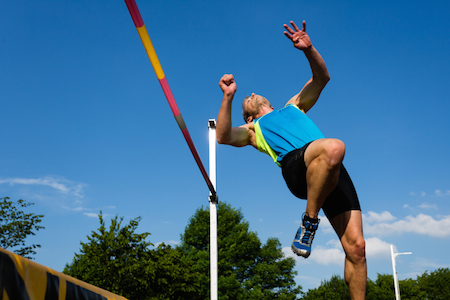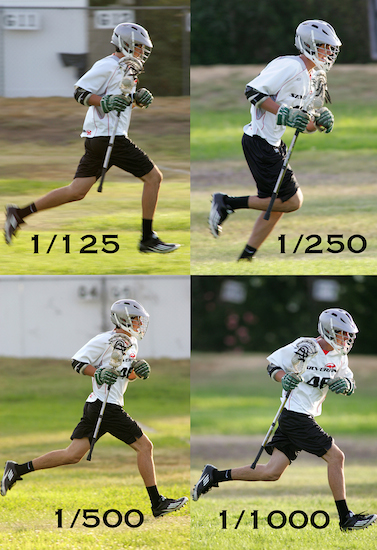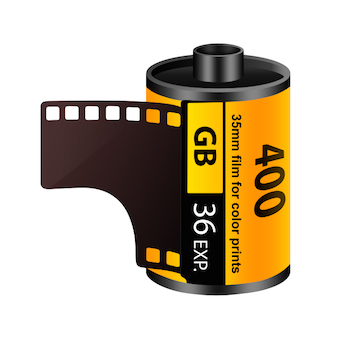Photographing Sports - Mastering the Big 3 Camera Settings (#4 in a series of 4)
So after reading this four part series on the Big Three Camera Settings, are you are starting to get an idea of how these three functions can control the look of your final image? Shutter speed can freeze or blur a moment. Aperture controls how much light you allow into your camera plus depth of field and the ISO setting tells your camera how sensitive it needs to be depending on the light in your scene. This is all good and well, but how do these three settings work to your advantage when photographing sports?
Let's back up a bit and talk about what the ideal action sports photo looks like. If you look at any sports magazine you will find some amazing sports photography and 90% of the time the photo will be sharp and clean, the mo ment will be frozen and the background will be out of focus with your attention riveted on the peak action in the frame. Now of course, rules were meant to be broken. So you will definitely find some images where the photographer intentionally blurred the action or the background is part of the scene like an amazing putt where the golfer celebrates while surrounded by hordes of spectators. For the most part, the beauty of sports photography is the freezing of a moment that happens too fast for the human eye to comprehend and making that moment stand out all alone - the isolation matching the level of focus being displayed by the athlete. Here is where understanding those 3 camera settings makes your sports images that much better.
ment will be frozen and the background will be out of focus with your attention riveted on the peak action in the frame. Now of course, rules were meant to be broken. So you will definitely find some images where the photographer intentionally blurred the action or the background is part of the scene like an amazing putt where the golfer celebrates while surrounded by hordes of spectators. For the most part, the beauty of sports photography is the freezing of a moment that happens too fast for the human eye to comprehend and making that moment stand out all alone - the isolation matching the level of focus being displayed by the athlete. Here is where understanding those 3 camera settings makes your sports images that much better.
Keeping your ISO low (100 or 200 ISO if possible) helps to keep the image clean and grain free. Of course if it is dark outside or you are shooting a night game, you will have to raise your ISO. Shutter Speed is going to help you freeze that moment. Using a shutter speed of 1/500 or higher will begin to freeze that moment with no blur. Finally, your Aperture is where you control how much light enters the camera and one more important element, Depth of Field. For a complete breakdown on Depth of Field, see my article devoted strictly to that subject. For the purpose of this photo tip, just know that Depth of Field controls how much is in focus in any given scene. When your aperture is wide open (f2.8 or f4) your background will start to go out of focus as opposed to an aperture setting of f16 where the background would stay in equal focus with the foreground. You ideally want your subject in focus and the background soft so that the eye goes right to the action.
So here is an example of an ideal camera setting for capturing an action photo on a bright sunny day:
ISO – 100
SHUTTER SPEED – 1/500 or higher
APERTURE – f2.8
This scenario would give you a crisp image that is frozen and has a short depth of field.
 I tell you this knowing that it is not always possible to use these settings. Maybe the scene is dark or maybe your lens aperture only allows you to open up to f5.6. That may very well be the case, but I wanted you to know this type of camera setting is what you are striving for and many times, you need to be able to control it manually rather than letting an Auto Sports Mode make your decisions for you. Take a few minutes this week and check out a sports magazine or scroll through your favorite news website to look at their sports images. Notice these three elements in play.
I tell you this knowing that it is not always possible to use these settings. Maybe the scene is dark or maybe your lens aperture only allows you to open up to f5.6. That may very well be the case, but I wanted you to know this type of camera setting is what you are striving for and many times, you need to be able to control it manually rather than letting an Auto Sports Mode make your decisions for you. Take a few minutes this week and check out a sports magazine or scroll through your favorite news website to look at their sports images. Notice these three elements in play.
When you shoot, don't worry if it not always perfect, but it is always good to know what you are aiming for and why a fellow photographer may be getting better photos even though you are shooting from the same angle and shooting the same action. Pro sports photographers know the tricks, and now, so do you.
Have a blast!
NEW! Free Sports Organization Resources
All of TeamSnap's ebooks, articles, and stories in one place. Access Now
Similar Articles:

Shutter Speed - Mastering the Big Three of Camera Settings (#1 in a series of 4)
Every time you take a photo, there are three main settings…
Read More

Sideline Etiquette
Today I would like to talk about the art of navigating the…
Read More

ISO - Mastering the Big Three Camera Settings (#3 in a series of 4)
Welcome back to our four part series about the basic camera…
Read More
